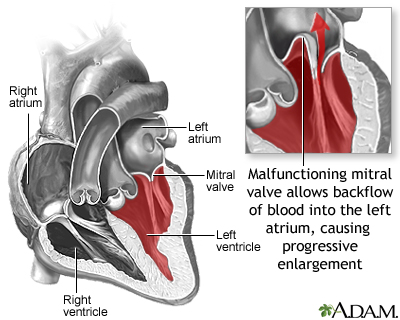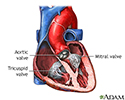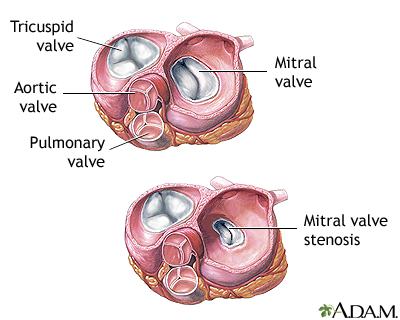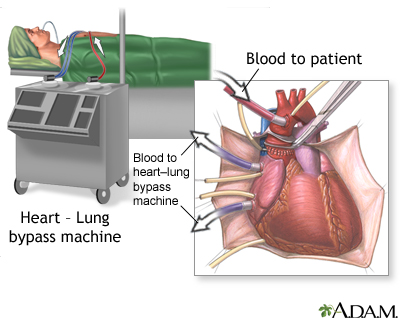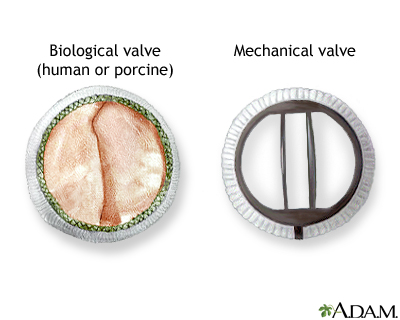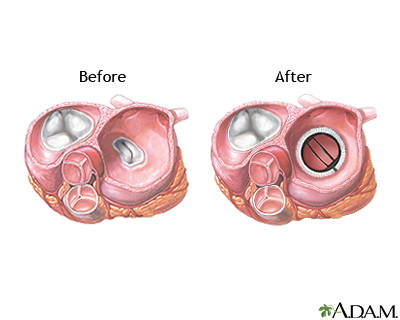Mitral valve prolapse
Barlow syndrome; Floppy mitral valve; Myxomatous mitral valve; Billowing mitral valve; Systolic click-murmur syndrome; Prolapsing mitral leaflet syndrome; Chest pain - mitral valve prolapse
Mitral valve prolapse is a heart problem involving the mitral valve, which separates the upper and lower chambers of the left side of the heart. In this condition, the valve does not close normally.
Causes
The mitral valve helps blood on the left side of the heart flow in one direction. It closes to keep blood from moving backwards when the heart beats (contracts).
Mitral valve prolapse is the term used when the valve does not close properly. It can be caused by many different things.
In most cases, it is harmless. The problem generally does not affect health and most people with the condition are not aware of it. In a small number of cases, the prolapse can cause blood to leak backwards. This is called mitral regurgitation.
Mitral valve prolapse often affects thin women who may have minor chest wall deformities, scoliosis, or other disorders. Some forms of mitral valve prolapse seem to be passed down through families (inherited).
Mitral valve prolapse is also seen with some connective tissue disorders such as Marfan syndrome and other rare genetic disorders.
Marfan syndrome
Marfan syndrome is a disorder of connective tissue. This is the tissue that strengthens the body's structures. Disorders of connective tissue affect...

Symptoms
Many people with mitral valve prolapse DO NOT have symptoms. The group of symptoms found in people with mitral valve prolapse is called "mitral valve prolapse syndrome," and includes:
- Chest pain (not caused by coronary artery disease or a heart attack)
- Dizziness
- Fatigue
- Panic attacks
-
Sensation of feeling the heart beat (
palpitations
)
Palpitations
A heart murmur is a blowing, whooshing, or rasping sound heard during a heartbeat. The sound is caused by turbulent (rough) blood flow through the h...
 ImageRead Article Now Book Mark Article
ImageRead Article Now Book Mark Article - Shortness of breath with activity or when lying flat (orthopnea)
When mitral regurgitation occurs, symptoms may be related to this leaking.
Exams and Tests
The doctor will perform a physical exam and use a stethoscope to listen to your heart and lungs. The provider may feel a thrill (vibration) over the heart, and hear a heart murmur (midsystolic click). The murmur gets longer and louder when you stand up.
Heart murmur
A heart murmur is a blowing, whooshing, or rasping sound heard during a heartbeat. The sound is caused by turbulent (rough) blood flow through the h...

Blood pressure is most often normal.
Echocardiogram is the most common test used to diagnose mitral valve prolapse. The following tests may also be used to diagnose mitral valve prolapse or a leaky mitral valve or complications from those conditions:
Leaky mitral valve
Mitral regurgitation is a disorder in which the mitral valve on the left side of the heart does not close properly. Regurgitation means leaking from ...

- Cardiac catheterization
- Chest x-ray
- CT scan of the chest
- ECG (may show arrhythmias such as atrial fibrillation)
- MRI of the heart
Treatment
Most of the time, there are few or no symptoms and treatment is not needed.
In the past, most people with heart valve problems were given antibiotics before dental work or procedures such as colonoscopy to prevent an infection in the heart. However, antibiotics are now used much less often. Check with your health care provider to see if you need antibiotics.
There are many heart medicines that may be used to control this condition. You may need surgery to repair or replace your mitral valve if it becomes very leaky (regurgitation), and if the leakiness also causes symptoms. However, this may not occur. You may need mitral valve repair or replacement if:
Mitral valve repair
Mitral valve surgery is surgery to either repair or replace the mitral valve in your heart. Blood flows from the lungs and enters a pumping chamber ...
- Your symptoms get worse.
- The left ventricle of your heart is enlarged.
- Your heart function gets worse.
Outlook (Prognosis)
Most of the time, mitral valve prolapse is harmless and does not cause symptoms. Symptoms that do occur can be treated and controlled with medicine or surgery.
Some abnormal heartbeats (arrhythmias) in people with mitral valve prolapse can be life threatening. If the valve leakage becomes severe, your outlook may be similar to that of people who have mitral regurgitation from any other cause.
When to Contact a Medical Professional
Call your provider if you have:
- Chest discomfort, palpitations, or fainting spells that get worse
- Long-term illnesses with fevers
References
Carabello BA. Valvular heart disease. In: Goldman L, Schafer AI, eds. Goldman's Cecil Medicine . 25th ed. Philadelphia, PA: Elsevier Saunders; 2016:chap 75.
Nishimura. RA, Otto CM, Bownow RO, et al. 2014 AHA/ACC Guideline for the management of patients with valvular heart disease: A report of the American College of Cardiology/American Heart Association task force on practice guidelines . J Thorac Cardiovasc Surg . 2014;148(1):e1-e132. PMID: 24939033 www.ncbi.nlm.nih.gov/pubmed/24939033 .
Otto CM, Bonow RO. Valvular heart disease. In: Mann DL, Zipes DP, Libby P, Bonow RO, Braunwald E, eds. Braunwald's Heart Disease: A Textbook of Cardiovascular Medicine . 10th ed. Philadelphia, PA: Elsevier Saunders; 2015:chap 63.
-
Mitral valve prolapse - illustration
Mitral valve prolapse is a disorder in which, during the contraction phase of the heart, the mitral valve does not close properly. When the valve does not close properly it allows blood to backflow into the left atrium. Some symptoms can include palpitations, chest pain, difficulty breathing after exertion, fatigue, cough, and shortness of breath while lying down.
Mitral valve prolapse
illustration
-
Heart valve surgery - Series
Presentation
-
Mitral valve prolapse - illustration
Mitral valve prolapse is a disorder in which, during the contraction phase of the heart, the mitral valve does not close properly. When the valve does not close properly it allows blood to backflow into the left atrium. Some symptoms can include palpitations, chest pain, difficulty breathing after exertion, fatigue, cough, and shortness of breath while lying down.
Mitral valve prolapse
illustration
-
Heart valve surgery - Series
Presentation
Review Date: 2/24/2016
Reviewed By: Michael A. Chen, MD, PhD, Associate Professor of Medicine, Division of Cardiology, Harborview Medical Center, University of Washington Medical School, Seattle, WA. Also reviewed by David Zieve, MD, MHA, Isla Ogilvie, PhD, and the A.D.A.M. Editorial team.

